Dispatches from Oxford in the Realm of England
Henry M. Miller, HSMC Director of Research
This blog reports the experiences and findings of Dr. Henry Miller while he is on assignment at the Centre for Medieval and Renaissance Studies at Oxford, England. From September 2011 to May of 2012, he will be conducting research about early Maryland and its English connections, writing, and teaching. Watch this space for Dr. Miller’s research findings, insights on the remarkable history and nature of Oxford and other places he visits, and curious aspects of living in another country.
February 19, 2012
Things are going well with lots of information being collected and connections being made. We have had two snowfalls, but neither was more than two inches. Not enough to be beautiful but quite sufficient to be hazardous. Over the past few weeks, I completed the research at Trinity College. This was the institution from which George Calvert and John Lewgar graduated and where Cecil Calvert studied. Among my goals was to find and record all references to these persons, gain a better understand of the nature of a Trinity education in the 1590 to 1625 period, and learn about their classmates and tutors. The archives of Trinity are stored in the gate tower of the Chapel.
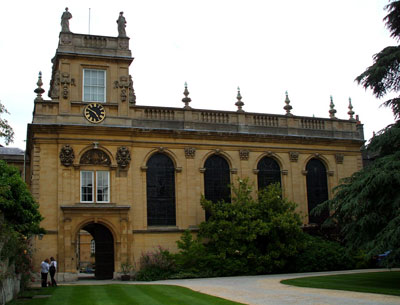
This Chapel was probably designed by Henry Aldrich, Dean of Christ Church College, with modifications made by the great architect Sir Christopher Wren. Construction began in 1691 and it was completed in 1694. It is in the words of that famous chronicler of England’s architecture Nicholaus Pevsner, “one of the most perfect ensembles of the late 17th century in the entire country” and possessing an “interior with wood carving of a quality not surpassed as an ensemble by anything in Britain.”
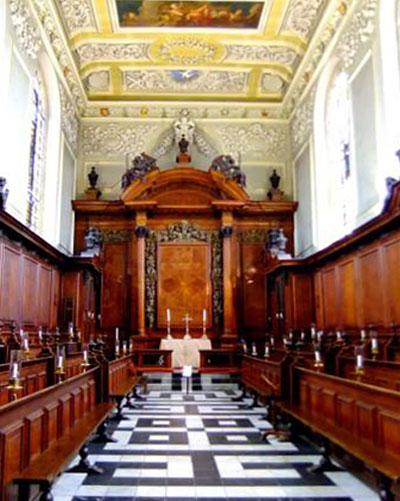
It was much needed as the old chapel in which the Calverts and Lewgar worshipped was in such bad shape that fellows and students “venture their lives every day in the face of possible collapse.” The interior is well preserved and quite beautiful. The carving is spectacular and uses five different types of wood – oak, cedar, lime, pear and walnut.
The two floors of the tower hold both the archives and work space, with the organ directly opposite the room where I worked.
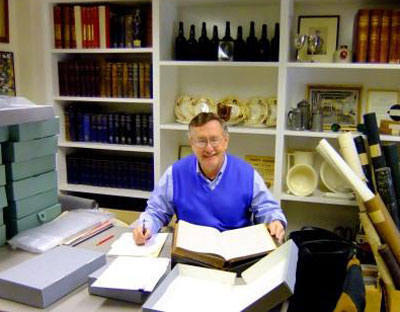
The organist practiced while I was there, providing a delightful musical accompaniment to the process of exploring those “quaint and curious volumes of forgotten lore”. It is really exciting to be turning the pages of a late 16th or early 17th-century account book and recognize the names of the Calverts, Lewger, and their classmates. I have already mentioned some of the documents about George in the November 27 Dispatch. However, at that time, I said the earliest evidence for George was 1595. That is wrong. Another book recently examined has the earliest date for George’s presence in Oxford
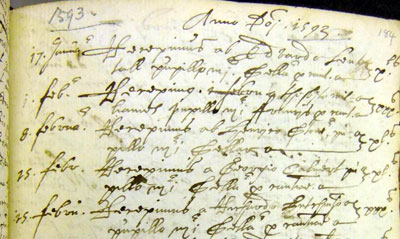
He is the fourth one down on this list and it is dated February 25 1593, recording the date of his admission into Trinity College. It is also of interest that another student Richard Hutchingson from Yorkshire is recorded on the same day. He was 18 years old, while George was only 14, so it is possible the older boy accompanied or escorted Calvert on their travel to Oxford.
Cecil Calvert matriculated from Trinity College and the earliest evidence of his presence is the caution money account for 1620.
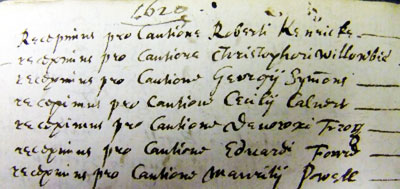
Caution money was a retainer payment in case the student damaged college property or failed to meet some financial obligation. It also gave the college a nice flow of ready cash when the new students arrived. The amount of Caution money varied by status and it is not surprising that Cecil, as the son of the Secretary of State for England, paid the highest amount of five pounds sterling. Where would Cecil have lived while at Trinity? This was one of a number of subjects that I have discussed with the College Archivist and historian, Clare Hopkins.
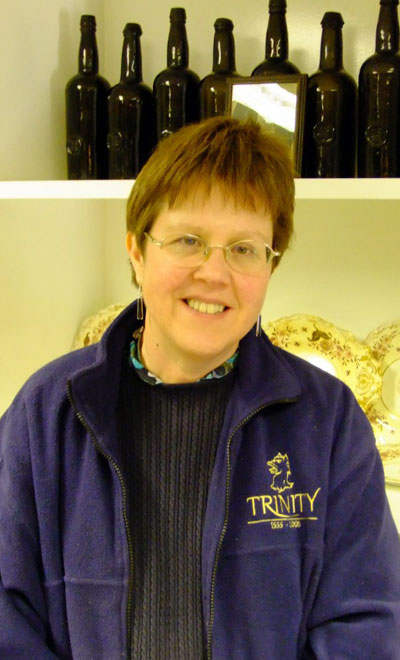
Clare has been incredibly helpful and I want to thank her and acknowledge how much assistance she has provided in not only opening up the archives but in sharing her deep knowledge of the college and Oxford with me. It is her considered opinion that Cecil would have been housed in the finest facilities then available. I completely agree with that, given his high social status. And the best place available was a three story lodging facility just completed by Trinity college President Ralph Kettell.
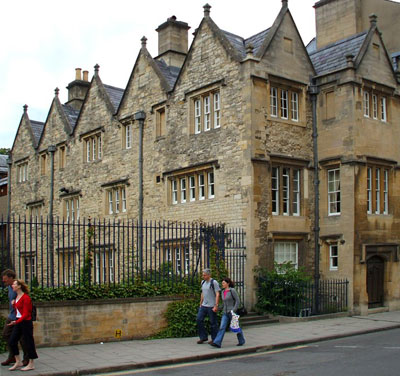
Built privately by the president between 1618 and 1620, it was brand new and had relatively spacious accommodations. The upper end rooms on Broad Street were especially nice, being south facing, and Clare suggests Cecil might have stayed in one of these. Unfortunately, there are no surviving documents to tell us where people were lodged, so we will never know for sure. But what is without question is that the one academic institution in the world that is directly tied to the idea of Maryland is Trinity College, Oxford. And its late 19th-century president Herbert Blackiston wrote in the first history of the college (1898) that “the most distinguished Trinity commoner of his time was certainly George Calvert.” It is thus regrettable that in the college’s Great Hall, with its walls covered by paintings of celebrated graduates, there is no image of perhaps its most illustrious late 16th century product and founder of two American colonies. I would love to change that.
In the Trinity Archives, there is a wide range of objects in addition to documents. Among them are complete 17th-century tobacco pipes found on the campus. The top one is of the form and size that could have been used while Cecil and John Lewger were here.
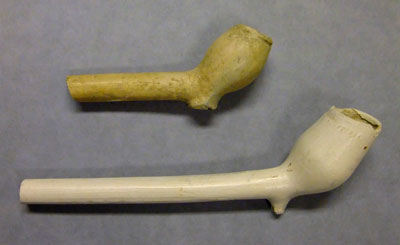
However, another group of items immediately caught my eye. These are animal bones from cattle and sheep.
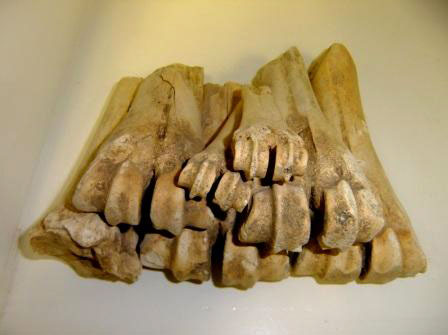
As an old archaeological “bone guy”, I knew immediately that these were all lower leg elements called metapodials, but why in the world would animal bones be in the archives? Clare kindly explained to me that they had been discovered packed together where a late 16th or 17th century building once stood in the Fellows’ Garden. It is depicted in a 1675 engraving of the college grounds. The bones had been used as construction materials to form a floor. While this seemed strange, a visit to the Oxford City Museum revealed that this was actually not a rare idea in Oxford. Other such floors have been discovered and they even preserved one example in the museum.
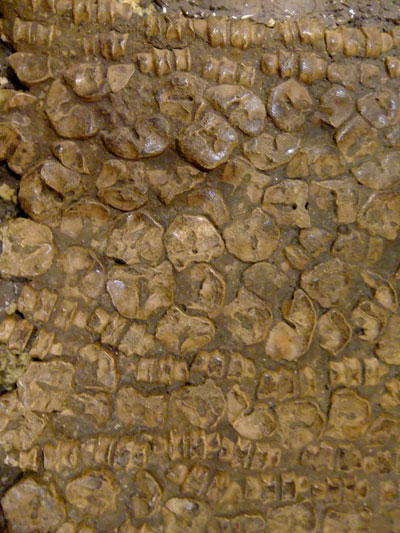
Constant consumption of animals at the University generated a lot of waste bone and these were found to make good, durable, and dry floors when properly laid. Always something new to discover here.
One of the most interesting things of late has been an invitation to attend the opening of a new art exhibit at the Pitt-Rivers Museum. General Augustus Pitt-Rivers was a British soldier who, upon retirement, began archaeology on major sites on his estates in southern England. At the same time, he collected objects made by cultures around the world. The excavations at Cranborne Chase between 1887 and 1898 were cutting edge in more ways than sharp shovels. His military engineering background influenced him to dig and record the findings with unprecedented precision, saving all artifacts, not just “treasures.” He also published the findings in four volumes that are a remarkable pioneering achievement. Every archaeologist has learned about Pitt-Rivers, and he deeply influenced the way sites are excavated and recorded. But what some may not know is that he also collected many thousands of cultural artifacts and established a tremendous museum here in Oxford to house many of these materials.
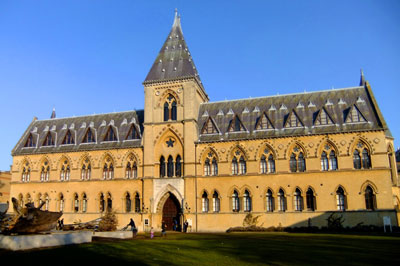
The Pitt-Rivers Museum is a world-class facility, linked today with a Natural History museum. But it is somewhat unusual. The General organized the 18,000 or so objects by functional type and insisted in his will that they be maintained in that organization. Thus, since his donation in 1884, the collection has grown to well over half a million objects and is the University Museum for anthropology and world archaeology. The main hall is rather remarkable with everything from a Northwest coast Totem Pole to complete boats, masks, pots, firearms, feather headdresses, amulets.
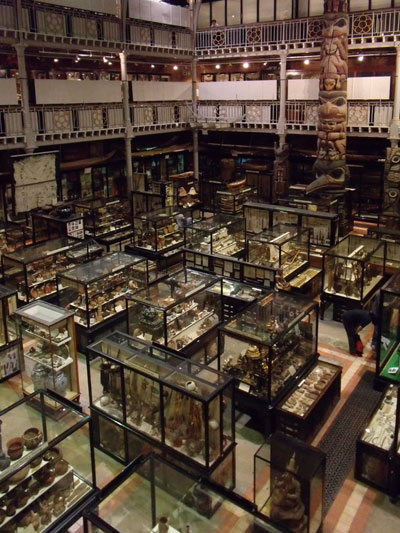
Easily the most memorable of the items are the genuine shrunken heads, which everyone seems to find their way to, drawing the attention of young and old. Among the more notable parts of the collection are the objects collected by Captain James Cook on his three voyages of exploration in the Pacific. These specimens hold vital information about the Pacific cultures before they were forever changed by contact. You name the type of object, and Pitt-Rivers has examples of it.
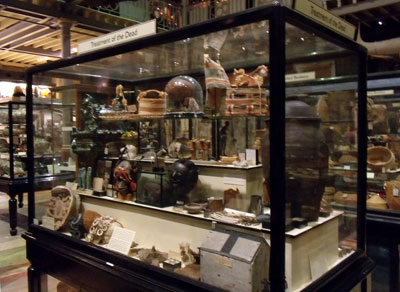
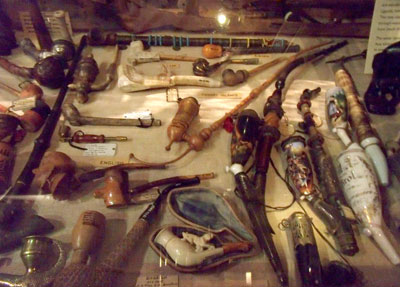
Today, two notable archaeologists Drs. Christopher Gosden and Daniel Hicks, work at the museum, while also teaching for the University.
General Pitt-Rivers continued to collect after making the donation to Oxford and assembled another 20,000 specimens. Unfortunately, they were sold off but he had an amazing catalogue made of the objects. The artifacts were not only numbered and described, but drawn in color by his most talented staff .
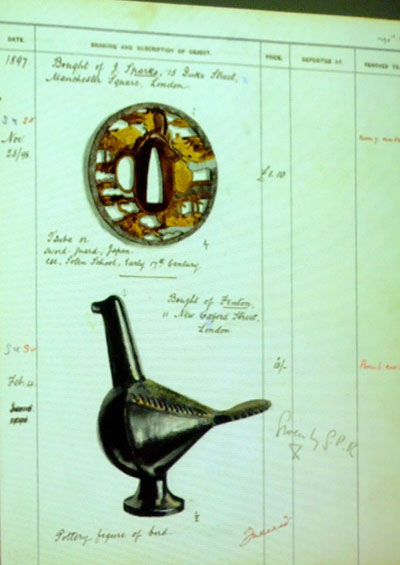
Few archaeological cataloguers today have such skills, reliant as we now are on photography and digital imagery. This brings me to the reason for attending the art exhibit. Susan Johnson, Professor of Art at St. Mary’s College of Maryland, was the first person to hold the Centre for Medieval and Renaissance Studies Visiting Scholar post (which I am currently privileged to have). While she was here, Sue learned about the catalogue and came up with the idea of using the images of objects Pitt-Rivers collected for artwork. In creating these new watercolors, she juxtaposed artifacts with natural specimens depicted in art. The result is a novel and quite beautiful series of images. Some of my favorites are shown here.
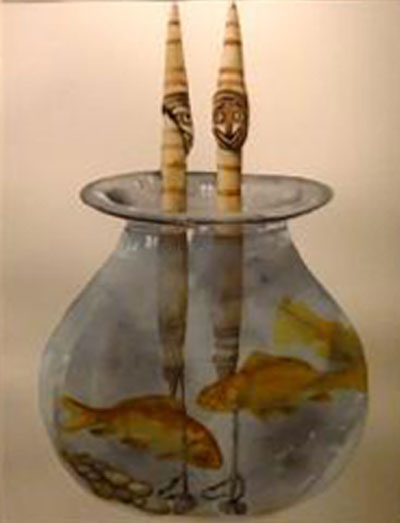
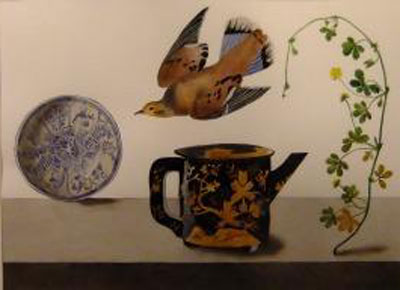
Sue also gave a presentation in the huge hall of the Pitt-Rivers that was well attended and quite interesting. As the century old Pitt-Rivers catalogues show, archaeology and art have long shared common interests and Sue’s use of these materials provides a striking new way of imagining objects in museum holdings. Here is a picture of Sue Johnson during her presentation and congratulations to her for this delightful exhibition.
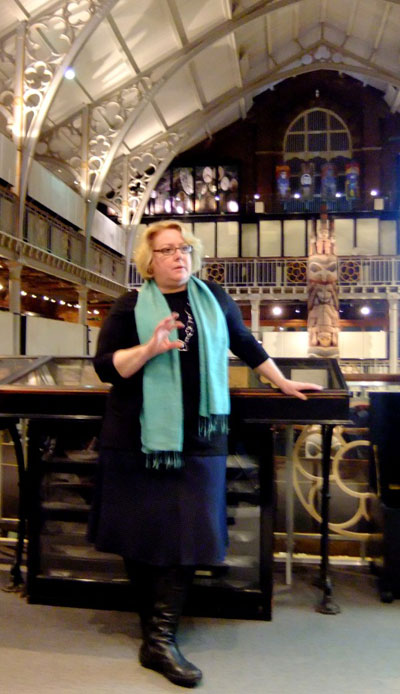
This coming week will focus on tracking down more information on the classmates of the Calverts and John Lewgar, as well as compiling more information about the man who served as Cecil Calvert’s chaplain after John Lewgar died in 1665. He was Humphrey Waring. His is another interesting story and he had prior Calvert connections. Specifically, he was a teacher at the Lisbon College Philip Calvert attended and may have taught Philip philosophy. Later, he came to London and was made head of the Chapter of Catholic priests in England who were not affiliated with religious orders like the Jesuits. Their records survive in London and one wonders if there is any information about Lord Baltimore, John Lewgar or others concealed within them.
Finally, one discovery from last week. You may remember that the Jesuit priest in charge of the Maryland province while the Brick Chapel was constructed was Henry Warren. He was called back from Maryland and his later story was not well known. Well, it turns out that his last years were spent at Catholic properties here in Oxfordshire, properties that were collectively known as “The House of St. Mary’s’” by the Jesuits. Interesting coincidence. And he died and is buried not six miles from Oxford, at one of these “House of St. Mary’s” estates – the manor of Waterperry. That was a surprise and I hope to visit that place to see if any marker survives for Father Warren, the man who revitalized the Maryland mission after the Restoration.


